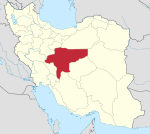Shahreza
Shahreza
Persian: شهرضا | |
|---|---|
City | |
 Mausoleum of Bibi Khaton in Shahreza | |
| Coordinates: 32°00′44″N 51°51′34″E / 32.01222°N 51.85944°E[1] | |
| Country | Iran |
| Province | Isfahan |
| County | Shahreza |
| District | Central |
| Population (2016)[2] | |
| • Total | 134,952 |
| Time zone | UTC+3:30 (IRST) |
Shahreza (Persian: شهرضا)[a] is a city in the Central District of Shahreza County, Isfahan province, Iran, serving as capital of both the county and the district.[4] Shahreza was selected as the national city of pottery in Iran in 2015. The reason for this choice was the high skill of the artists and the unique soil of this city.[citation needed]
At the 2006 National Census, its population was 108,299 in 30,368 households.[5] The following census in 2011 counted 123,767 people in 37,113 households.[6] The latest census in 2016 showed a population of 134,952 people in 43,478 households.[2]
Background
[edit]Shahreza is located 508 km south to Tehran and about 80 km south west to Isfahan and Zard Kooh mountain chain runs from north-west to south-east of the city, enjoying a cold climate. It is an old city which was first named Qomsheh, but later on its name was changed to Shahreza due to the existence there of the shrine of Shahreza. The most important tourist attractions are: Mahyar caravanserai, Shahreza caravanserai, the Shah Ghandab caves, located south-east of Shahreza, the Poodeh mosque, and Shahreza Imamzadeh. Other tourist attractions include the Amin Abad caravanserai, a Safavid Empire structure in Amin Abad, a village 42 km south of Shahreza.
Shahreza is a strategic city due to having large military bases, rail transportation system, very fertile soil, having the second largest industrial town in Iran (Razi town) and connecting the north to south.
It is interesting that a part of the old Silk Road passed through the Choghad Shahreza area.
History
[edit]It was one of the ancient territories of northern Pars (Persia) Satrapy in B.C. In the north of the county there is canyon of Orchiny (Orchine) that the main Iranian north-south high way passes through. The huge castle of Qomsheh was the latest place constructed by the Safavid Empire before the occupation of the capital Isfahan in the last of Safavid ages when Afghans captured it.
See also
[edit]Notes
[edit]References
[edit]- ^ OpenStreetMap contributors (22 June 2023). "Shahreza, Shahreza County" (Map). OpenStreetMap. Retrieved 22 June 2023.
- ^ a b "Census of the Islamic Republic of Iran, 1395 (2016)". AMAR (in Persian). The Statistical Center of Iran. p. 10. Archived from the original (Excel) on 19 October 2020. Retrieved 19 December 2022.
- ^ Shahreza can be found at GEOnet Names Server, at this link, by opening the Advanced Search box, entering "6013096" in the "Unique Feature Id" form, and clicking on "Search Database".
- ^ Habibi, Hassan (21 June 1369). "Approval of the organization and chain of citizenship of the elements and units of the national divisions of Isfahan province, centered in the city of Isfahan". Lamtakam (in Persian). Ministry of Interior, Defense Political Commission of the Government Board. Archived from the original on 4 February 2024. Retrieved 4 February 2024.
- ^ "Census of the Islamic Republic of Iran, 1385 (2006)". AMAR (in Persian). The Statistical Center of Iran. p. 10. Archived from the original (Excel) on 20 September 2011. Retrieved 25 September 2022.
- ^ "Census of the Islamic Republic of Iran, 1390 (2011)". Syracuse University (in Persian). The Statistical Center of Iran. p. 10. Archived from the original (Excel) on 17 January 2023. Retrieved 19 December 2022.
| Capital | |||||||||||||||
|---|---|---|---|---|---|---|---|---|---|---|---|---|---|---|---|
| Districts |
| ||||||||||||||
Text is available under the CC BY-SA 4.0 license; additional terms may apply.
Images, videos and audio are available under their respective licenses.


